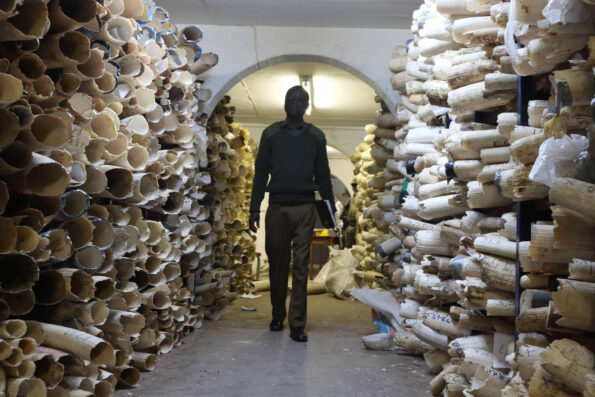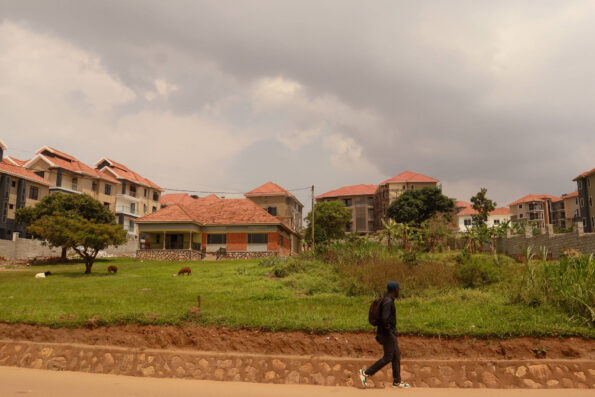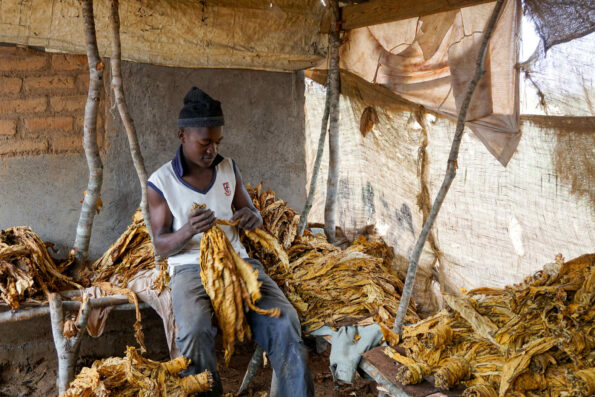
Thousands of pounds of damaged or overripe produce is thrown onto a pile at the side of the road outside the Kalimati Fruits and Vegetables Market in Kathmandu, the capital of Nepal.
KATHMANDU, NEPAL – Produce vendor Arjun Silwal is preparing to throw away 3,500 kilograms (7,716 pounds) of cabbages, bitter gourd, okra, radishes, maize, long beans and pumpkins. The heavy monsoon rains in August destroyed more produce than usual, keeping vegetables damp in the fields, during transport and unloading, and in market stalls, he says.
Silwal, 46, runs a shop at the state-owned Kalimati Fruits and Vegetables Market in Kathmandu, the capital of Nepal.
After closing up shop at 5 p.m., he gathers up and sorts the unsold vegetables. He packs ripe and lightly damaged vegetables into a few crates to be sold to street vendors the next day at a reduced price. He collects rotting, overripe and smashed vegetables in large plastic buckets and throws them onto a pile of spoiled produce at the side of the road outside the market.
The vegetables were part of a consignment of 5,000 kilograms (11,023 pounds) of vegetables, grown by farmers in the adjoining Dhading district, that were brought to Silwal’s shop two days before, he says.
Silwal says he has no alternative to disposing of the spoiled vegetables, which comprise 70 percent of the consignment.
“I have incurred a big loss,” Silwal says, a worried frown on his face. “I can't even get back my investment cost.”
Silwal, who has been a vegetable wholesaler since 1989, says food waste has been an ongoing problem for him and the farmers whose produce he buys.
Since the retail shop owners and individual customers who come to his shop want fresh produce, Silwal has to throw away vegetables that are overripe or have damaged skin, he says. Each day he throws away about 30 to 50 percent of the vegetables shipped to his shop.
To reduce wastage, Silwal lowers the prices of vegetables that are close to spoiling, he says. Nonetheless, he often ends up throwing away the marked-down vegetables to make room for fresh produce.
Silwal attributes the damage to farmers doing a poor job of grading and packing produce. Much produce is packed in polyethylene bags instead of crates, exposing it to damage in transit, he says.
Recently, tough enforcement of Nepal’s Food Act, which sets food quality standards and establishes penalties for failing to uphold them, has increased losses to farmers and traders.
The Department of Food Technology and Quality Control, the agency responsible for enforcing the act, started conducting surprise inspections of the produce at the Kalimati Market in July, Silwal says. If an inspector finds excessive traces of pesticides or fertilizers in some kind of produce, the wholesaler has to throw away the entire product.
Such inspections have increased the amount of discarded produce by about 5 percent, Silwal says, based on his observations.
“I started a vegetable wholesaler’s shop to earn some money,” he says. “However, it has been very difficult to do so, due to the problem of wastage and rotting of the vegetables.”
On average, Silwal loses 60,000 rupees ($613) to 65,000 rupees ($664) a day to wastage, he says.
Nepalese vegetable farmers and wholesalers bear heavy financial losses from the large-scale dumping of damaged and spoiled produce in wholesale markets. Nearly half of the produce that farmers ship to local vendors is dumped after a few days because it spoils quickly in the open-air markets. Striving to alleviate the problem, the government is developing a network of cold storage facilities to extend the shelf life of produce. It also is working to minimize food wastage by training farmers and transporters to properly grade and pack produce.
Arjun Prasad Aryal, director of the Kalimati Fruits and Vegetables Market Development Board, which manages the Kalimati Market, sees wastage at the market every day.
About 650 metric tons (716 short tons) of vegetables arrive at the wholesale market every day, most of it from the Kathmandu Valley, Aryal says. On average, 15 metric tons (16.5 short tons) to 25 metric tons (27.5 short tons) of vegetables are discarded daily because they are found to be damaged.
The amount of wastage may have increased since Department of Food Technology and Quality Control officials began conducting inspections in July, Aryal says. But the market development board has not conducted research to confirm that impression.
Vegetables account for most of the produce being dumped, says Balaram Prasad Koirala, program director of the Post Harvest Management Directorate of the Ministry of Agriculture Development. Few Nepalese farmers grow fruit for sale. Most farmers cultivate vegetables; those who grow fruit generally do so only for their own consumption.
Wastage raises the cost of produce, often putting it beyond the reach of the average consumer, says Rameshwor Khanal, an economist and former secretary of the Ministry of Finance.
The government supervises 22 vegetable and fruit wholesale markets in Nepal, says Hari Babu Tiwari, program director at the Agribusiness Promotion and Marketing Development Directorate of the Ministry of Agricultural Development, the main government agency to market agricultural products and promote agribusiness.
Public markets discarded about 20 to 50 percent of the 3.2 million metric tons (3.5 million short tons) of vegetables produced in Nepal in 2011-2012, according to a 2012-2013 report published by the Nepal Food Scientists and Technologists Association and the ministry.
The waste is caused largely by farmers failing to grade or properly pack vegetables and fruits before shipping them, says Shrawan Adhikary, program officer at the Food and Agriculture Organization of the United Nations in Nepal.
Grading ensures that spoiled or overripe produce is not mixed with fresh produce, and packing produce according to uniformity of size reduces damage during transport, he says.
About 30 to 40 percent of vegetables produced in Nepal are damaged in transport every day, Adhikary says, citing informal research data from Nepal’s Ministry of Agricultural Development.
Kanchha Lama, 33, a farmer in Makwanpur district, does not agree that farmers are to blame for damage to produce.
Lama, like all farmers, does not pack damaged vegetables with good-quality ones because he knows that rotting vegetables will spoil the fresh produce it touches, he says. He is especially careful to properly sort and grade tomatoes and carrots, which can rot easily. This careful sorting takes time.
After sorting, they pack the best produce in the few plastic crates they have and put the rest in polyethylene bags, Lama says. But farmers can’t afford to pack all their produce in crates.
A plastic crate, which holds 25 kilograms (55 pounds) of produce, costs 500 rupees ($5), he says. A large polyethylene bag that holds 10 kilograms (22 pounds) of produce costs only 5 rupees (5 cents).
“But sometimes, during a long-distance transport, the vegetables can rot in the arid conditions before they reach the wholesalers,” he says.
On average, about 20 to 30 percent of the vegetables he sends to market are discarded because of spoilage, Lama says.
“Wholesalers throw the produce away if it does not sell,” he says. “Our labor goes to waste. We are mostly suffering loss. But we have no other alternative. Who will understand our plight?”
Both farmers and wholesale traders bear the cost of this wastage, Lama says. But because wholesalers pay farmers only for the produce they sell, the farmers bear the biggest losses from wastage. Lama rarely earns back the money he invests in growing his vegetables.
“I invest more than 65,000 rupees ($664) to grow the vegetable crops in one season, but I earn only about 25,000 rupees ($255) from it,” Lama says.
A cultivation season spans three to four months.
When Lama does not earn back his investment, he must borrow money from cooperative banks to plant his next crop, he says.
The financial loss Lama incurs from his vegetable farming is taking a toll on his family, he says.
Lama had hoped to send his children to a private school in his village, Phakhel village development committee, but he cannot afford to do so. Further, he cannot afford new clothes for his family for religious festivals and celebrations.
Another reason produce is thrown away is that supply often exceeds consumer demand, Aryal says.
Vegetables that haven’t sold by the day after they were brought to market are dumped at sites in Kirtipur, 5 kilometers (3 miles) outside Kathmandu city, and at Sisdol, in the adjoining Nuwakot district, 22 kilometers (13.6 miles) away.
The produce is dumped because buyers want only fresh vegetables, Aryal says.
Vegetable wholesalers believe this situation can improve if farmers consult them about planting cycles and the types of vegetables they should grow.
Such coordination would be good for both wholesalers and farmers, as a mutual understanding can clarify the optimum amount of vegetables to be shipped for sale, says Mahesh Khanal, a vegetable wholesaler at the Kalimati Market.
“There is no coordination between the farmers and the wholesalers, and the farmers do not consult us about the kind of vegetables that are out of stock at the market,” he says.
Lama, the Makwanpur farmer, agrees that better coordination would alleviate wastage. Farmers need clearer information from wholesalers, he says.
In farming regions, all the farmers produce the same vegetables during the peak production season, which coincides with the June-to-September rainy season, Lama says. As a result, large quantities of the same vegetables reach the market during the peak production season and few vegetables are sent to the market during the low-production season, from December to May.
“We farmers do not know which vegetables sell in which season,” Lama says. “It takes months of effort to grow vegetables. We sweat and work hard to produce the farm products to earn some money.”
Government agencies are attempting to bring about some changes.
One planned solution is to build cold storage facilities to extend the shelf life of fresh produce.
The government allocated 100 million rupees ($1 million) in the 2013-2014 fiscal year to build cold storage facilities in five cities across the country, Tiwari says. The Agribusiness Promotion and Marketing Development Directorate chose to site the facilities in the five regional headquarters of Nepal – commercial centers with large regional markets.
However, since construction bids came in over budget, the government is reviewing the plans and considering smaller storage facilities. Construction of the storage facilities, including one in Kathmandu, is expected to begin in the current fiscal year, which ends on July 15, 2015, Tiwari says.
Produce can be kept in a storage facility for a week to six months, depending upon the nature of the food and the facility’s temperature and humidity level.
The cold storage facilities will reduce wastage by more than 75 percent every week, Tiwari says. If farmers or wholesalers can store vegetables in these facilities for even a week, decay will be minimized.
Radha Pun, who farms vegetables in Rolpa district, in Nepal’s Mid-Western region, looks forward to having access to cold storage facilities.
“If the government builds the cold storage facilities, I could store the produce that does not sell and sell it during the offseason,” Pun, 34, says in a phone interview.
But vegetable shop owner Silwal is skeptical about the advantages of cold storage. Vegetables kept in cold storage are not as tasty as fresh vegetables, so there is less demand by consumers, he says.
“Fresh vegetables which do not sell in a day are also difficult to sell after storing in the cool storage,” he says.
In addition to planning the storage facilities, government agencies are training farmers and transporters to reduce damage by properly packing and transporting produce.
The Kalimati Fruits and Vegetables Market Development Board also promotes the proper packing and grading of vegetables by farmers, Aryal says. In addition, it encourages traders to sell older vegetables at low prices instead of letting them rot.
For five years, the Agribusiness Promotion and Marketing Development Directorate has been working with Agriculture Development Offices in all districts to train over 1,300 farmers a year to grade and carefully package vegetables before sending them to markets, Tiwari says. District Agriculture Development Offices work with farmers to develop agriculture production.
Koirala says training farmers alone will not solve the problem of vegetable waste. Those who transport vegetables also need training.
Sometimes farmers contract with middlemen to have their transport workers grade, package and load vegetables at their farms and unload them at markets, Koirala says. But these workers are day laborers who do not stay on the job long, so training them would not be useful.
“So we are not able to improve the situation with regards to wasted vegetables,” he says.
Sunil K.C., a middleman who buys vegetables from farmers, transports them and then sells them to wholesalers, says he and his workers don’t have time to carefully grade and pack produce.
“We have to send the produce on time to the market,” he says in a phone interview. “So sometimes we can’t grade and package it before sending to the wholesalers because of the short time limit.”
Despite these challenges, the District Agriculture Development Offices continue to work with farmers to address the wastage caused by damage, Tiwari says.
In addition to providing training, they distribute crates to farmers at a subsidized cost of 250 rupees ($2.60) apiece to encourage them to properly grade and pack vegetables.
The training has been effective for some, such as Pun, who was trained under the program by the District Agriculture Development Office in Rolpa district in 2012.
Having applied the techniques of the packaging and grading that she learned in her training, she has been able to sell her vegetables easily and without wastage in the market, Pun says.
In addition, her new grading system has given her the confidence to ask wholesalers for better prices, she says. She has been earning more money since undergoing the training.
Before she started to sort and grade her produce, she earned about 40,000 rupees ($408) a year. She now earns up to 150,000 rupees ($1,532) a year.
“I only sell graded vegetables,” Pun says. “That's why I demand more money than other farmers.”
GPJ translated this article from Nepali.







